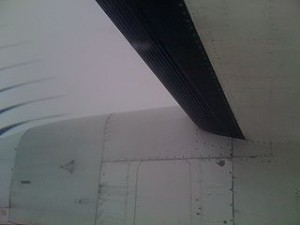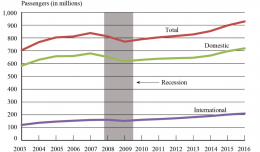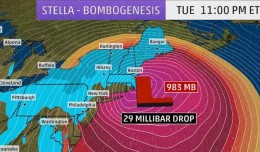The snow from today’s coastal storm has turned to ice pellets in New York City and surrounding areas. Ice pellets are frozen rain – not freezing rain. It indicates there is an inversion which is a warmer layer of air at a higher altitude. As the rain falls through air temperature that is dropping and falls below zero Celsius, the raindrop freezes into a pellet.
This is of concern to pilots. When flying through this area where the rain is crystalizing, an aircraft can quickly be coated in thousands of pounds of ice. Ice disrupts the airflow over the aircraft’s surface which may impact its ability to stay airborne. For turbojet pilots, the concern is small. Pilots may activate the engine and wing heat more quickly, and be alert for critical altitudes which must be vacated quickly due to the ice accumulation. The reason there is only a small concern for these pilots is the immense power of the jet engine allows the aircraft to quickly climb through or out of these altitudes. Descents are also rapid minimizing the time in these critical altitudes.
For pilots of turboprop aircraft, the concern is a little greater. These aircraft lack the heated wings of the turbojets and use inflatable boots to remove ice that has accumulated. Because of this, they cannot maintain flight as long in icing conditions with heavy accumulations. And with slower climbs and descents, the pilots of these aircraft must be more alert for critical icing conditions. However, with what manufacturers have learned in the nearly 80 years of flying with this type of deicing system and the training pilots receive, there is no reason for a passenger to be concerned. If the situation is of too high a risk, the Captain will cancel the flight or divert while en route.
If a pilot of a small aircraft without any deicing equipment like a Cessna 182 were to fly today, within only a few minutes the aircraft would be descending as if it were approaching a runway to land. The engine would be at full power and the pilot would be declaring an emergency. The outcome would likely be fatal.
Today is a very challenging day for airlines. The dispatchers are deciding which flights should be canceled and what considerations must be made for those that will still go. Pilots on the ground are watching the lines for takeoff and referencing charts telling them how much time is available before the deicing fluid on the wings begins to fail. Pilots on approach are alert for pilot reports of the braking effectiveness on the runway. Pilots descending into the terminal area are carrying a little extra power to keep the leading edges properly heated from the engine’s heat. Pilots en route are receiving messages from dispatchers on holding and are planning descending into the icing conditions. And not to forget the baggage handlers that are wet and cold, the deicers that are cold and soaked in glycol deicing fluid, and the ground controllers working with inbound and outbound aircraft and getting them to the gate or runway without undo delay.
Still, the system remains incredibly safe. The odds of an airline accident today remain exceptionally small. That is in contrast with the road system that today will generate an exceptional amount of work for bodyshops and junkyards alike, and unfortunately numerous fatalities. Traction control, anti-lock brakes, and airbags have greatly increased the safety of driving, but the car has not adjusted to threatening weather conditions like we have today as well as the airline industry.
NYCAviation Columnist David J. Williams is a former airline Captain and currently involved with aviation safety.








